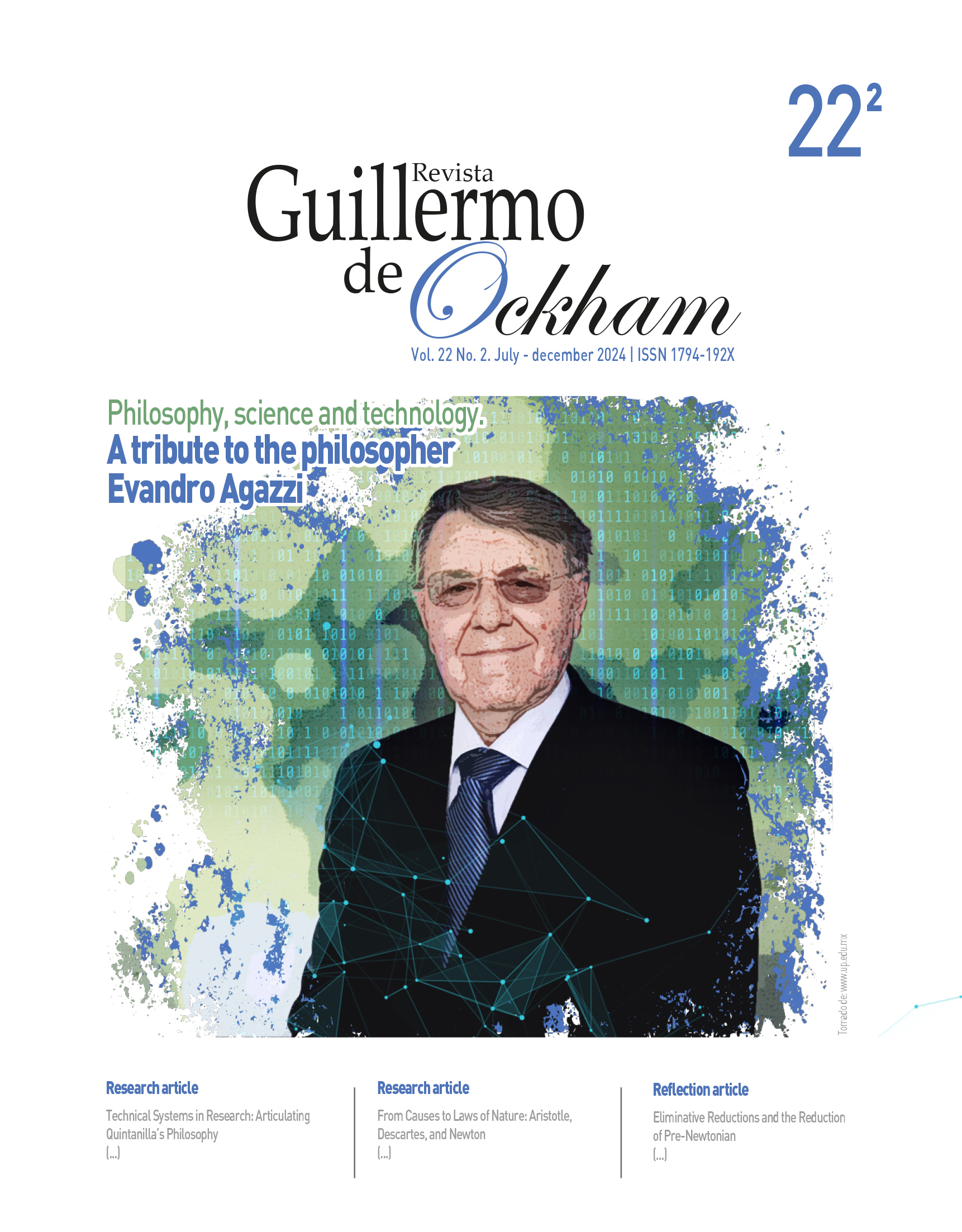The Revista Guillermo de Ockham provides an immediate and open access to its content, based on the principle of offering the public a free access to investigations to provide a global interchange of knowledge.
Unless otherwise established, the contents of this journal has a license with Creative Commons Attribution-NonCommercial-NoDerivatives 4.0 International (CC BY-NC-ND 4.0) http://creativecommons.org/licenses/by-nc-nd/4.0/
- Attribution: You must give appropriate credit, provide a link to the license, and indicate if changes were made. You may do so in any reasonable manner, but not in any way that suggests the licensor endorses you or your use.
- NonCommercial: You may not use the material for commercial purposes.
- NoDerivatives: If you remix, transform, or build upon the material, you may not distribute the modified material.
- No additional restrictions: You may not apply legal terms or technological measures that legally restrict others from doing anything the license permits.
Abstract
Medicine is characterized by its diagnostic power, a strong consensus among professionals when diagnosing, and a standardized classification system of diseases (i. e. the WHO ICD). On the other hand, nursing faces a disconnect between theory and practice (theory-practice gap, Risjord, 2010), even though it is currently supported by the nursing care process (NCP), a standardized diagnostic system (NANDA), and its own academic corpus. However, the lack of integration between theoretical research and practice impacts the NCP, particularly in the diagnosis, which differs from the medical one due to its taxonomy and language. In that sense, both diagnoses are analyzed from a Kuhnian perspective to identify the differences that affect the success of nursing in the health care system. It is hypothesized that the gap between theory and practice contributes to the lack of robustness in nursing diagnosis, so the objective is to specify how this gap manifests itself. Finally, by virtue of the characteristics of philosophical research, the methodological perspective of this article focuses on the conceptual and critical analysis of the selected bibliographical material.
Keywords:
References
Aggleton, P., y Chalmers, H. (1986b). Nursing research, nursing theory and the nursing process. Journal of Advanced Nursing, 11(2), 197-202. https://doi.org/10.1111/j.1365-2648.1986.tb01237.x
Alligood, M. R. (2014). Introducción a las teorías en enfermería: historia, importancia y análisis. En M. R. Alligood y A. M. Tomey (Eds.), Modelos y teorías en enfermería (pp. 2-13). Elsevier.
Alligood, M. R., y Tomey, A. M. (Eds.). (2014). Modelos y teorías en enfermería. Elsevier.
Balzer, W., Moulines, C. U., y Sneed, J. D. (1987). An architectonic for science: The structuralist program. Reidel.
Barajas-Ochoa, A., y Ponce-Horta, A. M. (2018). Reconocer los errores diagnósticos, un paso necesario para abordarlos. Salud Pública México, 60(1), 109-110. https://doi.org/10.21149/8418
Conant, L. H. (1967). Closing the practice-theory gap. Nursing Outlook, 15(11), 37-39.
Durán de Villalobos, M. M. (2007). Teoría de enfermería ¿un camino de herradura? Aquichuan, 7(2), 161-173. https://aquichan.unisabana.edu.co/index.php/aquichan/article/view/110
España López, A. M. (2016). Correlación entre el modelo conceptual y el modelo profesional del cuidado. Revista de Enfermería ENE, 10(2). https://scielo.isciii.es/scielo.php?script=sci_arttext&pid=S1988-348X2016000200009&lng=es&nrm=iso&tlng=es
Fawcett, J. (2005). Contemporary nursing knowledge: Conceptual models of nursing and nursing theories. F. A. Davis.
Federico, L. (2017). Una mirada filosófica del proceso de atención en enfermería: aportes a la enseñanza en enfermería. Revista Territorios del Cuidado, 2(1), 63-76. http://ridaa.unq.edu.ar/handle/20.500.11807/3498
Federico, L. (2020). Modelos y teorías en la ciencia del cuidado: aclaraciones epistemológicas. Cultura de los Cuidados, 24(56), 300-314. https://doi.org/10.14198/cuid.2020.56.21
Federico, L., y Giri, L. A. (2023). Organizing nursing knowledge from metatheoretical structuralisms viewpoint. En C. Abreu (Ed.), Philosophy of science in the 21st century: Contributions of metatheoretical structuralism (pp. 155-179). NEL; UFSC.
Flaherty, K. M. (2014). Neuman systems model in nursing practice. En M. R. Alligood (Ed.), Nursing theory: Utilization and application (pp. 200-221). Elsevier.
Gordon, M. (2000/2015). Pasado, presente y futuro de los diagnósticos de enfermería. Cultura de los Cuidados, 19(42), 172-178. http://dx.doi.org/10.14198/cuid.2015.42.16
Guerrero Pino, G. (2000). Elección de teoría, juicios de valor y racionalidad en Kuhn. Éndoxa: Series Filosóficas, 1(13), 15-32. https://doi.org/10.5944/endoxa.13.2000.4982
Herdman, T. H., Kamitsuru, S., y Lopes, C. T. (2021). Diagnósticos enfermeros: definiciones y clasificación 2021-2023 (12.a ed.). Elsevier.
Hernández Conesa, J., Moral de Calatrava, P., y Esteban Albert, M. (2003). Fundamentos de la enfermería: teoría y método. McGraw-Hill.
Kuhn, T. S. (1962/1992). La estructura de las revoluciones científicas. FCE.
Kuhn, T. S. (1984/2017). Desarrollo científico y cambio de léxico. FIC-Udelar; ANII; SADAF.
Kuhn, T. S. (2000). The road since structure (J. Conant y J. Haugeland, Eds.). University of Chicago Press.
Lorenzano, C. J. (1977). Análisis metodológico de una ciencia empírica: la medicina. Diánoia, 23(23), 124-136. https://doi.org/10.22201/iifs.18704913e.1977.23.931
Lorenzano, C. J. (2007, julio). El devenir de la medicina: una mirada epistemológica [Ponencia]. Congreso Internacional Extraordinario de Filosofía, San Juan, Argentina.
Lorenzano, C. J. (2023). The structure of the medical clinic. En C. Abreu (Ed.), Philosophy of science in the 21st century: Contributions of metatheoretical structuralism (pp. 181-188). Universidad Federal de Santa Catalina.
Mason, G. M. C., y Attree, M. (1997). The relationship between research and the nursing processing clinical practice. Journal of Advanced Nursing, 26(5), 1045-1049. https://doi.org/10.1046/j.1365-2648.1997.00472.x
Masterman, M. (1970/1975). La ciencia normal y sus peligros. En I. Lakatos y A. Musgrave (Eds.), La crítica y el desarrollo del conocimiento (pp. 159-202). Grijalbo.
Mayoral, J. V. (2021). Decision-making in medicine. Teorema: Revista Internacional de Filosofía, 40(1), 133-149. https://dialnet.unirioja.es/servlet/articulo?codigo=7817969
Neuman, B. (2011). The Neuman systems model. En B. Neuman y J. Fawcett (Eds.), The Neuman systems model (5.a ed., pp. 3-33). Pearson.
Orem, D. (2003). Self-care and health promotion: Understanding self-care. En K. Rempenning y S. Taylor (Eds.), Self-care theory in nursing: Selected papers of Dorothea Orem (pp. 212-222). Springer.
Organización Mundial de la Salud [OMS]. (2019). CIE-11: Clasificación Internacional de Enfermedades, 11.a revisión. Guía de referencia. https://icd.who.int/es/docs/Guia%20de%20Referencia%20(version%2014%20nov%202019).pdf
Reed, P. G., y Lawrence, L. A. (2008). A paradigm for the production of practice-based knowledge. Journal of Nursing Management, 16(4), 422-432. https://doi.org/10.1111/j.1365-2834.2008.00862.x
Risjord, M. W. (2010). Nursing knowledge: Science, practice and philosophy. Wiley-Blackwell. https://doi.org/10.1002/9781444315516.ch6
Saborido, C. (2020). Filosofía de la medicina. Tecnos.
Seaback, W. (2006). Nursing process: Concepts and application (2.a ed.). Thomson Delmar Learning.
Solomon, M., Simon, R. J., y Kincaid, H. (Eds.). (2017). The Routledge Companion to philosophy of medicine. Routledge.
Thagard, P. (2006). What is a medical theory? En R. Payton y L. McNamara (Eds.), Multidisciplinary approaches to theory in medicine (pp. 47-62). Elsevier.
Upshur, R., y Chin-Yee, B. (2017). Clinical judgment. En M. Solomon, R. J. Simon y H. Kincaid (Eds.), The Routledge Companion to philosophy of medicine (pp. 363-371). Routledge.

 Perfil Google Scholar
Perfil Google Scholar































